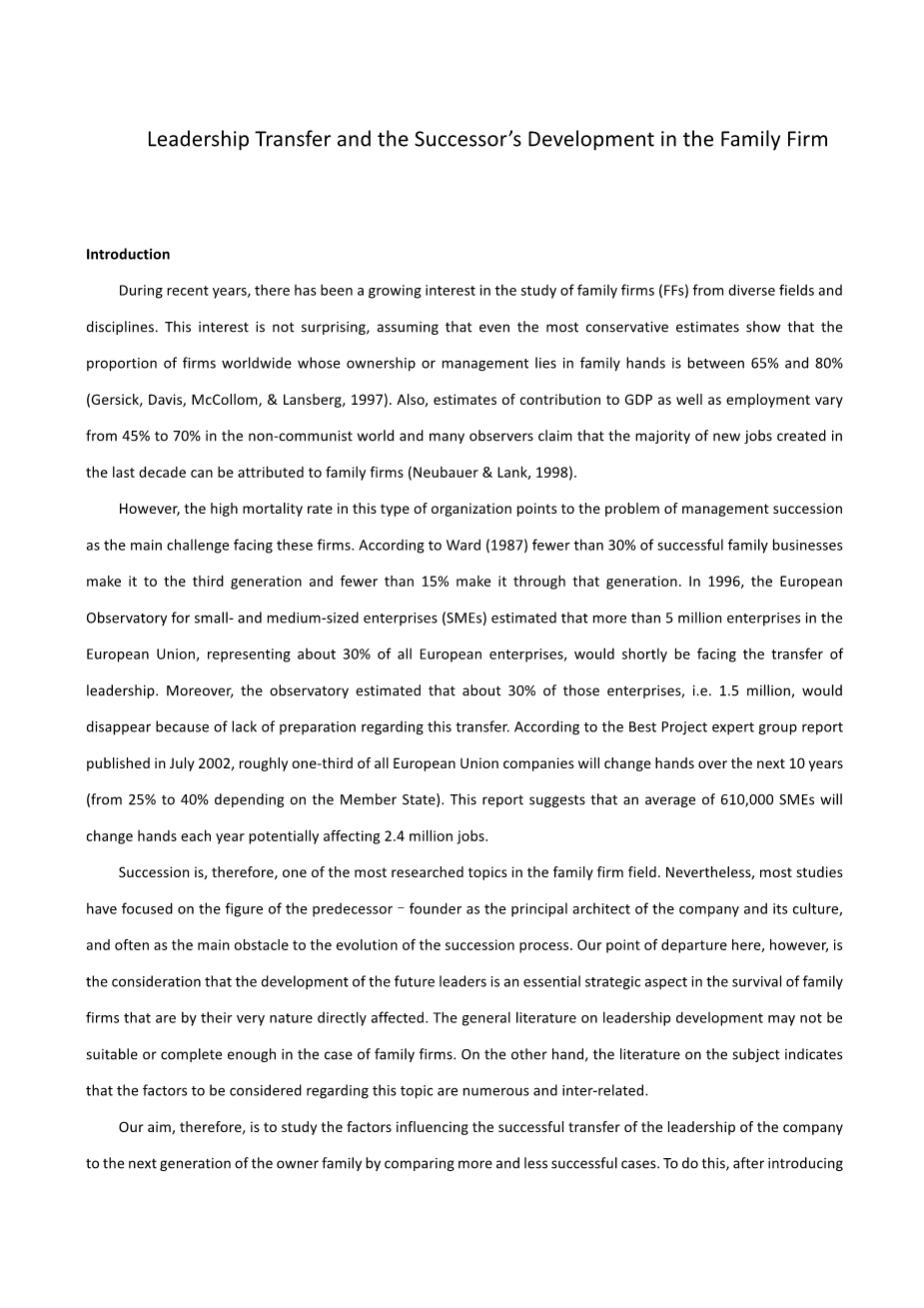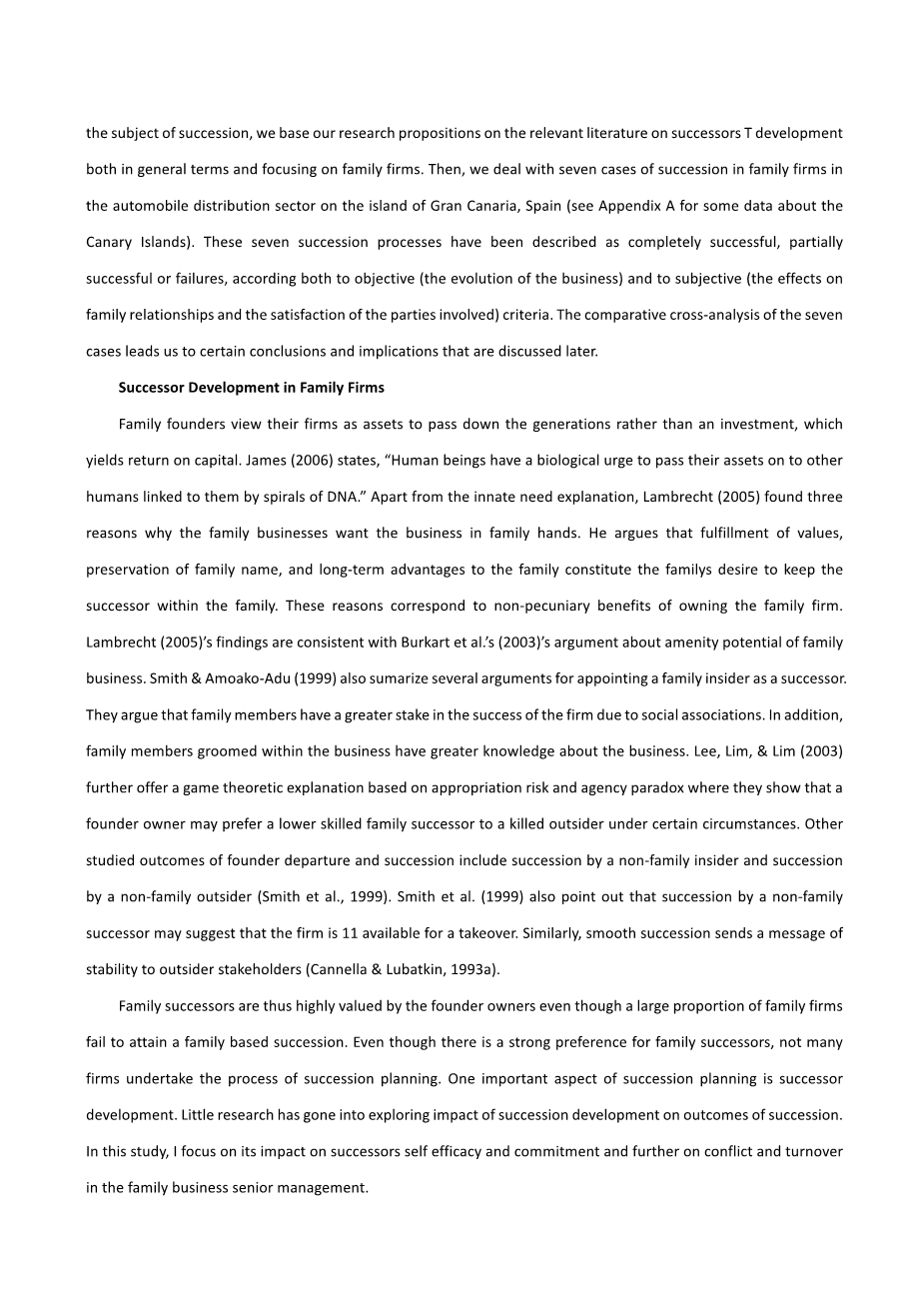

英语原文共 8 页,剩余内容已隐藏,支付完成后下载完整资料
Leadership Transfer and the Successorrsquo;s Development in the Family Firm
Introduction
During recent years, there has been a growing interest in the study of family firms (FFs) from diverse fields and disciplines. This interest is not surprising, assuming that even the most conservative estimates show that the proportion of firms worldwide whose ownership or management lies in family hands is between 65% and 80% (Gersick, Davis, McCollom, amp; Lansberg, 1997). Also, estimates of contribution to GDP as well as employment vary from 45% to 70% in the non-communist world and many observers claim that the majority of new jobs created in the last decade can be attributed to family firms (Neubauer amp; Lank, 1998).
However, the high mortality rate in this type of organization points to the problem of management succession as the main challenge facing these firms. According to Ward (1987) fewer than 30% of successful family businesses make it to the third generation and fewer than 15% make it through that generation. In 1996, the European Observatory for small- and medium-sized enterprises (SMEs) estimated that more than 5 million enterprises in the European Union, representing about 30% of all European enterprises, would shortly be facing the transfer of leadership. Moreover, the observatory estimated that about 30% of those enterprises, i.e. 1.5 million, would disappear because of lack of preparation regarding this transfer. According to the Best Project expert group report published in July 2002, roughly one-third of all European Union companies will change hands over the next 10 years (from 25% to 40% depending on the Member State). This report suggests that an average of 610,000 SMEs will change hands each year potentially affecting 2.4 million jobs.
Succession is, therefore, one of the most researched topics in the family firm field. Nevertheless, most studies have focused on the figure of the predecessor–founder as the principal architect of the company and its culture, and often as the main obstacle to the evolution of the succession process. Our point of departure here, however, is the consideration that the development of the future leaders is an essential strategic aspect in the survival of family firms that are by their very nature directly affected. The general literature on leadership development may not be suitable or complete enough in the case of family firms. On the other hand, the literature on the subject indicates that the factors to be considered regarding this topic are numerous and inter-related.
Our aim, therefore, is to study the factors influencing the successful transfer of the leadership of the company to the next generation of the owner family by comparing more and less successful cases. To do this, after introducing the subject of succession, we base our research propositions on the relevant literature on successors T development both in general terms and focusing on family firms. Then, we deal with seven cases of succession in family firms in the automobile distribution sector on the island of Gran Canaria, Spain (see Appendix A for some data about the Canary Islands). These seven succession processes have been described as completely successful, partially successful or failures, according both to objective (the evolution of the business) and to subjective (the effects on family relationships and the satisfaction of the parties involved) criteria. The comparative cross-analysis of the seven cases leads us to certain conclusions and implications that are discussed later.
Successor Development in Family Firms
Family founders view their firms as assets to pass down the generations rather than an investment, which yields return on capital. James (2006) states, “Human beings have a biological urge to pass their assets on to other humans linked to them by spirals of DNA.” Apart from the innate need explanation, Lambrecht (2005) found three reasons why the family businesses want the business in family hands. He argues that fulfillment of values, preservation of family name, and long-term advantages to the family constitute the familys desire to keep the successor within the family. These reasons correspond to non-pecuniary benefits of owning the family firm. Lambrecht (2005)rsquo;s findings are consistent with Burkart et al.rsquo;s (2003)rsquo;s argument about amenity potential of family business. Smith amp; Amoako-Adu (1999) also sumarize several arguments for appointing a family insider as a successor. They argue that family members have a greater stake in the success of the firm due to social associations. In addition, family members groomed within the business have greater knowledge about the business. Lee, Lim, amp; Lim (2003) further offer a game theoretic explanation based on appropriation risk and agency paradox where they show that a founder owner may prefer a lower skilled family successor to a killed outsider under certain circumstances. Other studied outcomes of founder departure and succession include succession by a non-family insider and succession by a non-family outsider (Smith et al., 1999). Smith et al. (1999) also point out that succession by a non-family successor may suggest that the firm is 11 available for a takeover. Similarly, smooth succession sends a message of stability to outsider stakeholders (Cannella amp; Lubatkin, 1993a).
Family successors are thus highly valued by the founder owners even though a large proportion of family firms fail to attain a family based succession. Even though there is a strong preference for family successors, not many firms undertake the process of succession planning. One important aspect of succession planning is successor development. Little research has gone into exploring impact of succession development on outcomes of succession. In this study, I focus on its impact on successors self efficacy and commitment and further on confl
剩余内容已隐藏,支付完成后下载完整资料
资料编号:[469516],资料为PDF文档或Word文档,PDF文档可免费转换为Word
您可能感兴趣的文章
- 薪酬满意度作为工作满意度的先行因素:建立一个回归模型,确定公共和私人组织中薪酬满意度与工作满意度之间的线性关系外文翻译资料
- 胜任力与胜任力、胜任力模型与胜任力模型的比较研究外文翻译资料
- 如何提高企业网络招聘的有效性外文翻译资料
- 为初级职位招聘大学生,在制定战略和战术校园招聘计划时,需要考虑哪些问题?外文翻译资料
- 基于能力的招聘:招聘和留住成功员工的关键外文翻译资料
- 员工培训对体育门票销售人员工作满意度的影响外文翻译资料
- 由雇主参与的创新型员工激励模式外文翻译资料
- 浅析企业文化与企业绩效的相关性 ——以苏州金色未来信息咨询股份有限公司为例外文翻译资料
- 互联网背景下基于平衡计分卡的计算机绩效评价系统外文翻译资料
- 提高斯洛伐克公共行政部门招聘过程的效率外文翻译资料


